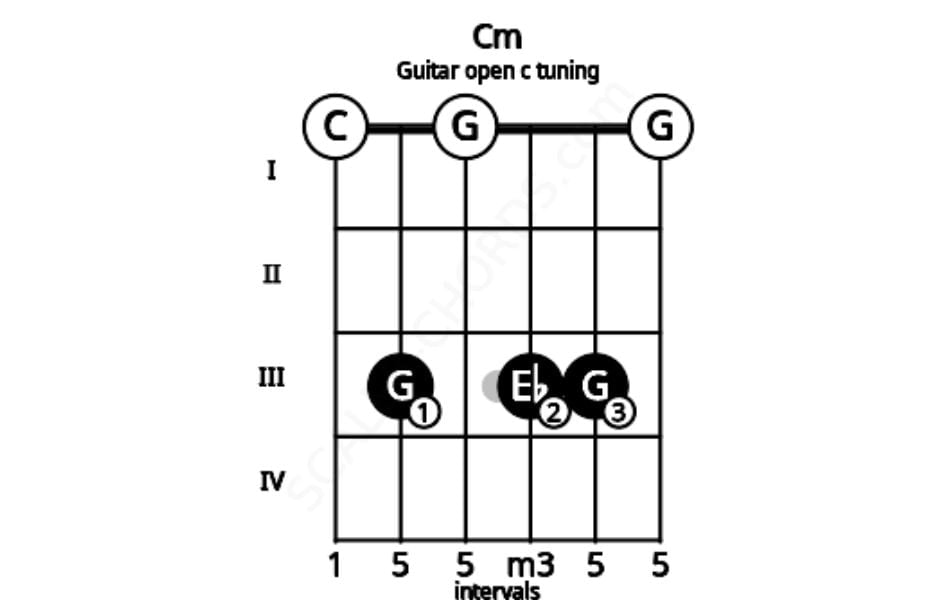Open C tuning is indeed a popular choice among guitarists for its versatility and unique sound. If you’re considering exploring open tunings, this guide will provide you with essential information about Open C tuning chord shapes.
Contents
What are open C tuning chord shapes
The term open C tuning chord shapes refers to the specific chord voicings that can be played on a guitar that is tuned to open C tuning (C-G-C-G-C-E). In open C tuning, the strings are tuned in such a way that strumming the open strings creates a C major chord.
Open C tuning chords are the finger placements or fret positions on the guitar’s fretboard that allow you to play different chords in open C tuning without the need to bar or fret any additional notes. Therefore, these chord shapes make use of the open strings and the unique tuning to produce various chords with a specific tonality and sound.
How to tune open C chord
Before you get the correct chords, you need to make sure the instrument has the correct open c tuning applied. To tune your guitar to open C tuning (C-G-C-G-C-E), follow these steps:
Start by detuning all your strings to ensure you are starting from the same point. You can do this by using a tuner or tuning app to tune each string to a reference pitch (such as A440).
- Tune your sixth string (lowest string) to C.
- Tune your fifth string (A string) down two whole steps to G.
- Tune your fourth string (D string) down one whole step to C.
- Leave your third string (G string) unchanged. It already matches the G in open C tuning.
- Tune your second string (B string) down one whole step to G.
- Tune your first string (high E string) down one whole step to C.
Once you’ve tuned all the strings according to the open C tuning, strumming all the strings without fretting any notes should produce a C major chord. Now you are ready to explore the unique sounds and chord shapes that open C tuning offers.

Some typical open C tuning chord shapes
Open C tuning chord shapes have a variety of super-easy chord shapes to master. Let’s explore some key chord shapes that can be utilized in Open C tuning. The beauty of many of these chord shapes lies in their mobility, allowing you to play them across the entire fretboard.
Major chord shapes
The Major chord shape in Open C tuning is incredibly straightforward. Strumming all open strings produces an open C major chord. For any other Major chord, you can easily create it by using a finger to barre across the fret and align the note on the sixth string with the root of the desired chord.
- C Major: 000000 (strum all open strings)
- G Major: 000002 (fret the 2nd fret of the 5th string)
- G7: 000001 (fret the 1st fret of the 5th string)
- F Major: 000001 (fret the 1st fret of the 5th string)
- D Minor: 000000 (strum all open strings)
- A Minor: 003000 (fret the 3rd fret of the 6th string)
- E Major: 000220 (fret the 2nd fret of the 4th and 5th strings)
- A7: 003000 (fret the 3rd fret of the 6th string)
- D7: 000202 (fret the 2nd fret of the 4th string and 2nd fret of the 2nd string)

C Minor chord
In Open C tuning (C-G-C-G-C-E), the Open C Minor chord is formed by placing your fingers in specific positions on the fretboard. So, Here’s the chord shape and how to play it:
- Chord Shape: 003030
- Fingers: Place your index finger on the 3rd fret of the 5th string
- Your middle finger on the 3rd fret of the 3rd string
- Your pinky finger on the 3rd fret of the 2nd string.
- Strumming: Strum all strings from the 5th to the 1st.

When you play this chord shape, it creates the C Minor chord in Open C tuning. The C Minor chord has a somber and melancholic sound, making it a valuable chord to use in various musical styles.
In conclusion, open C tuning chord shapes offer a world of possibilities for guitarists seeking to explore new horizons in their playing. The unique chord shapes available in this tuning, along with the flexibility and adaptability it provides, make it a popular choice among musicians.
